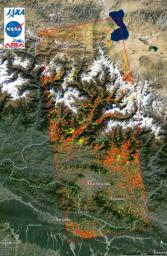
Figure 1
Click on the image for larger versionNASA data and expertise are providing valuable information for the ongoing response to the April 25, 2015, magnitude 7.8 Gorkha earthquake in Nepal. The quake has caused a significant humanitarian crisis and has killed more than 8,000 due to widespread building damage and triggered landslides throughout the region. This was the strongest earthquake to occur in the region since the 1934 Nepal-Bihar magnitude 8.0 quake caused more than 10,000 fatalities.
In the disaster response efforts, scientists at NASA's Jet Propulsion Laboratory, Pasadena, California; and the California Institute of Technology in Pasadena have once again applied a previously developed algorithm to produce a Damage Proxy Map (DPM) to help identify the areas that were hardest-hit during the earthquake and to assist responders. The new DPM can be viewed at PIA14710.
A previous DPM of the greater Kathmandu area was used to identify building collapses (PIA19311), using data from the Italian Space Agency's COSMO-SkyMed satellites, and is now being used to help prioritize where new satellite imagery will be collected. The newly generated DPM uses data from the Japanese Aerospace Exploration Agency (JAXA) ALOS-2 satellite and covers a larger geographic area, including the steep terrain of the Himalayas, where it is proving effective in identifying earthquake-triggered landslides.
The Advanced Rapid Imaging and Analysis (ARIA) team at JPL and Caltech generated a 43-by-112 mile (70-by-180 kilometer) Damage Proxy Map covering the city of Kathmandu and Langtang region, using L-band interferometric synthetic aperture radar data from JAXA's ALOS-2 satellite. The technique uses a prototype algorithm to rapidly detect surface changes caused by natural or human-produced damage. The assessment technique is most sensitive to destruction of the built environment or significant changes in the ground surface. When the radar images areas with little to no destruction, its image pixels are transparent. Increased opacity of the radar image pixels reflects damage, with areas in yellow-orange-red reflecting the potential of light, moderate and heaviest damage to cities and towns. The map covers changes in the region between Feb. 21, 2015 and May 2, 2015. Each pixel in the DPM is about 100 feet (30 meters) across.
The perspective image (Figure 1) shows the DPM overlaid on the terrain with the locations of landslides identified by the National Geospatial-Intelligence Agency (NGA) preliminary damage assessment, using before and after optical imagery (May 4 damage assessment product). As an example, the images on the side show how red regions in the DPM correlate with landslide debris, as shown by the dark surface in the "after" image. The basemap images were provided by Google. Before and after images were provided by DigitalGlobe.
ARIA is a JPL- and NASA-funded project being developed by JPL and Caltech. It is building an automated system for providing rapid and reliable GPS and satellite data to support the local, national and international hazard monitoring and response communities. Using space-based imagery of disasters, ARIA data products can provide rapid assessments of the geographic region impacted by a disaster, as well as detailed imaging of the locations where damage occurred. ALOS-2 radar data were made available for the disaster response by JAXA through Committee on Earth Observation Satellites (CEOS) in support of the response effort.
For more information about ARIA, visit http://aria.jpl.nasa.gov.
The Damage Proxy Map displayed as a .kmz file in Google Earth is available at http://aria-share.jpl.nasa.gov/events/20150425-Nepal_EQ/DPM/ARIA_DPM_ALOS2_v0.5u_DG_20150506.kmz.

 Planetary Data System
Planetary Data System













